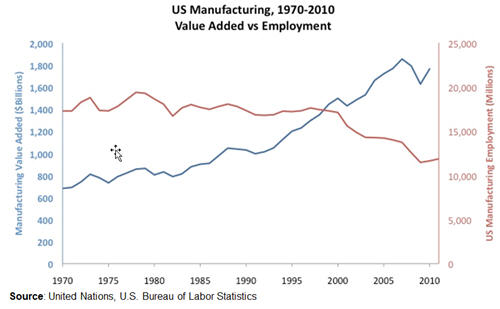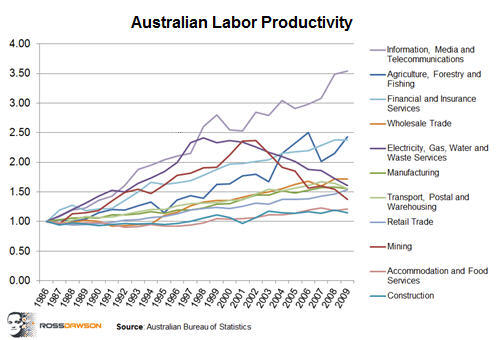How divergence in labor productivity is shaping the future of work
My recently launched Future of Work framework provides a highly summarized overview of the future of work. Over coming months I will delve into specific aspects of the framework.
One of the most important issues is divergence in labor productivity, mentioned as the fourth point under Labor Productivity in the Economic Structure section.
Across industries as well as countries, the productivity of labor is diverging dramatically, creating job opportunities in some sectors and constraining them in others. There are many broader issues in shifts in labor productivity that I’ll come back to another time. For now, it’s worth looking at these two charts.

Source: Andrew McAfee

The first chart shows dramatically increased multi-factor productivity across the US manufacturing sector. This includes improved labor productivity, however it also indicates a dramatic shift where labor is a far smaller proportion of total value add in the sector.
The second chart looks at Australia, showing trends in labor productivity since 1985 by industry. Workers in the information industry are over 3.5x as productive as they were 25 years earlier. On the other hand, construction workers and accommodation and food services basically have the same labor productivity, with – for different reasons – minimal impact of technology on productivity.
One of the interesting aspects of the chart is the rise and then fall of mining labor productivity. While there are many factors, an important one is simply the cost of workers in mining, driven up by extraordinary demand during the recent mining boom.
Agricultural productivity has improved substantially due to automation and new mining techniques.
The divergence in labor productivity is related to the issue of the polarization of work.
Labor demand is consistent where there is low productivity growth – such as in food services – however the wages and conditions in these kinds of jobs are usually under significant pressure.
Where labor productivity growth is high, in some cases, such as manufacturing, it leads to fewer jobs, however the jobs that remain are usually more highly-skilled and better paying. In growth industries such as information and computing, productivity growth can in fact be accompanied by increase in high-value jobs.
Of course a highly nuanced analysis needs to be done to understand the factors shaping diverging labor productivity, and there are many disagreements about the causes and implications. However certainly this divergence will shape where there are job opportunities in the future, and how attractive they are.
[UPDATE:] See a great post by Andrew McAfee who generated the first chart above with excellent commentary.
